Our top choices
Our Choice
Fly Bikes Ruben
The tires that came with my first BMX bike. Super large and forgiving. Perfect for dirt jumping on nicely built jumps. Just be careful of the leaves.Check Price
Cheapest
DMR Moto RT
Cheapest but actually one of the best. Brilliantly designed by DMR with a simple tread pattern but clever rubber technology.Check Price
Upgrade Pick
Maxxis Grifter
Widely regarded as one of the best BMX tires on the market. Perfect for all types of riding. Super simple treat pattern with fast rolling speed.Check Price
Tires are important, whether it’s for BMX, Mountain Biking or Dirt Jumping. Your tires are the only point of contact you have with the ground when riding. Having the right tires for your riding discipline inflated to the right pressure and fitted in the right direction will provide you with the confidence to ride on the edge.
Buying the right tires for dirt jumping could give you that extra bit of grip when hitting a berm or the extra speed you need to sail over that dirt jump you’re too scared to hit. These days there are so many rubber compounds, tread patterns and sizes it’s very intimidating when trying to choose the right one.
This post is going to go through several of the best tires you can buy for dirt jump or slopestyle riding. These aren’t scientifically the best tires you can buy but I will outline the positives and negatives for every product on this list.
1. Kenda Small Block Eight XC Tire
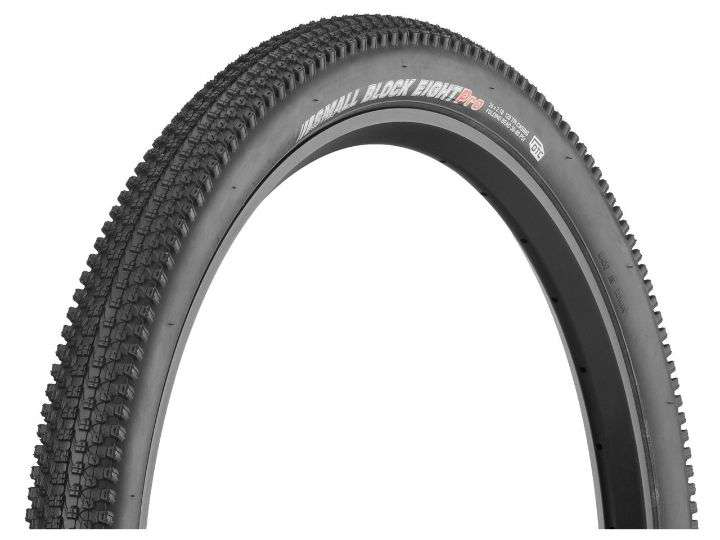
Since 1962 Kenda Tires have been making rubber tires for bikes. Established in Yuanlin, Taiwan the company worked hard and expanded their product list dramatically over the next several decades.
Bike tires were followed by motorbikes, which were followed by lawn mowers and trailer tires in the ’70s and ’80s. Since the onset of the 1990’s Kenda has done everything. They established factories in China and America, expanded further into more product lines, acquired companies like Martin Wheel Company, Dexter Wheel Company and Monitor Manufacturing. Various factories spread out throughout the world to develop the best rubber tires for people in those countries.
Bicycle tires were the first product Kenda focused on. It’s no surprise that after nearly 60 years of development, these mountain bike tires are some of the best you can buy.Loose dirt and gravel good. Light and sturdy
The Small Block 8’s aren’t actually featured in the company’s dirt jump and slopestyle category. They make these tires for XC racing. You may be wondering why I have included this tire on this list if they aren’t even considered dirt jumping tires. The answer is that there are just so many stellar reviews and recommendations for them from slopestyle riders throughout the world.
A Nevegal shape has been used with a tread pattern that uses smaller, more frequent knobs to provide a better, more accurate bite. Kenda’s Dual Tread Compound provides more stability when cornering and a faster centre line acceleration. This tire provides a great amount of speed on loose, uneven terrain.
Many riders mention the ability to use this product on a wide variety of terrain from sand to gravel, mulch and loose dirt. The only downside being they aren’t brilliant in wet or super muddy conditions. I believe this is because of the tread pattern being shallower than regular mountain bike tires. Stability in muddy conditions seems to have been substituted for speed and cornering.
I think these are perfect for the dirt jumps. Most tracks are so hard-packed that you can effectively use BMX tires. Low risk of water and mud with a slightly loose track sounds perfect for Kenda.
Specifications:
- Dual Tread Compound
- Downhill Casing
- Year Released: 2015
- TPI: 120
- Bead: Folding
- Width: 2.1”
- Max Pressure: 80 PSI
- Weight: 580g
Click Here to Check Best Price
2. Maxxis Holy Roller MTB
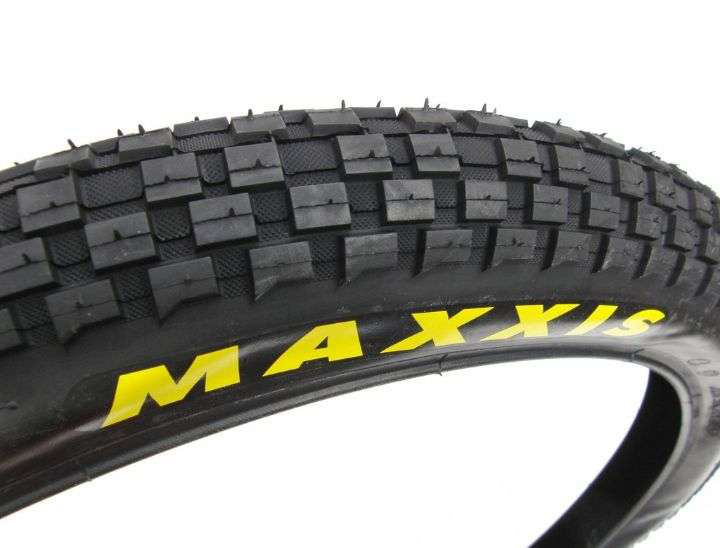
Maxxis are another rubber company that started out small in Taiwan in the 1960s. The business grew rapidly, expanding to over 30,000 employees in most of Asia and Europe. They are now the largest manufacturers of bicycle tires in the world.
This tire is another checkerboard style. The squares aren’t identical in size or symmetrical on either side. This isn’t a bad thing, it helps the tire bite onto loose dirt and gravel much easier. An inverted semi-knob design enables the tire to roll extremely smoothly on dirt and concrete.
This tire is more concentrated towards off-road riding than others on this list. Regular commuter riding will be comfortable but the advantages of the tire are best shown when off-road.
The Kenda K-Rads are probably the closest competitors to the Holy Rollers. In direct comparison, Kenda has made a much more durable tire that will keep it’s grip longer and provide more miles but Maxxis has done well to create a tire with great predictability, traction and compliance.
Checkerboard tread patterns are great for grip in semi-favourable conditions like dirt jump tracks and pump tracks but they’re lacking a bit in water and mud. This isn’t a bad thing as these tires are intended for use on DJ tracks but it’s something to take note of.
Specifications:
- TPI: 60
- Bead: Wire
- Weight: 231g – 571g
- Max PSI: 60PSI – 85PSi
Click Here to Check Best Price
3. DMR Moto Dirt Jump Tire
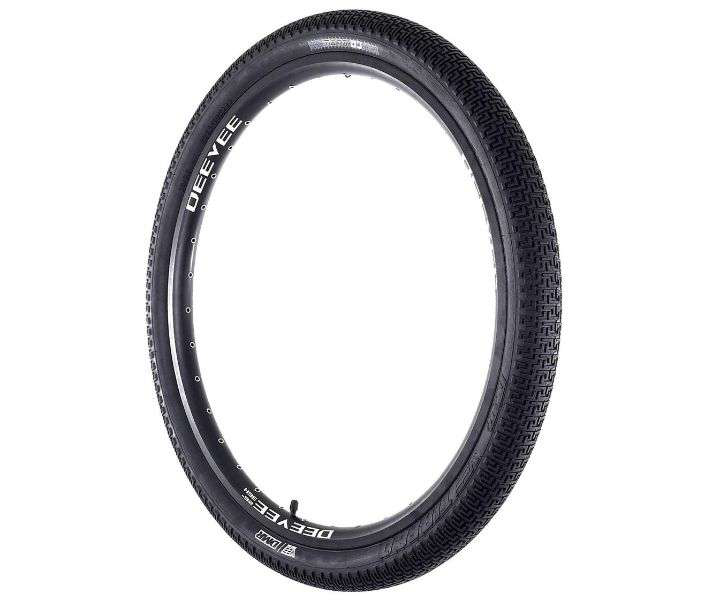
DMR bikes are a big player in the world of DJ and slopestyle bikes. Sponsoring some of the biggest players like Brendan Fairclough and Andreu Lacondeguy they’ve got a wealth of knowledge at their disposal for developing new products.
The DMR Supermoto tire was super popular when I first started riding dirt jumps. For over 10 years DMR successfully sold the supermoto tire all over the world. The Moto DJ is the successor to this empire.
When looking at the Moto DJ there’s no major difference to the original. The intriguing maze style tread pattern still covers nearly the whole surface with options for regular and white-walled tires. Performance and durability enhancements are the main reasons for the update. DMR knew they already had a successful design and just needed to keep up with the market.
Vee Tire Co. is the collaborative partner for this product. I don’t know the extent of their involvement although they’ve created a great product for dirt jumps, pump tracks and the skatepark.
I just want to make one final point about how interesting the tread pattern is on this tire. The whole pattern is made from right angles and variations on the square bracket icon ‘]’. The centreline is made from a series of these square brackets interspersed with an extended right angle or ‘L’ shape.
Around the edge, there is a series of single right angles emanating from small ones nearer the centre. Just as the pattern rounds the tire onto the sidewall there is a single opposite ‘L’ shape to almost encasing the others inside it.
Specifications:
- Bead: Steel or Folding
- Sizes: 26”
- TPI: 60, 120
- Weight: 750g, 695g
Click Here to Check Best Price
Best Stem for DJ
Find the strongest and most comfortable bike stem to use while riding dirt jumps.
4. Maxxis Grifter Folding BMX Tire
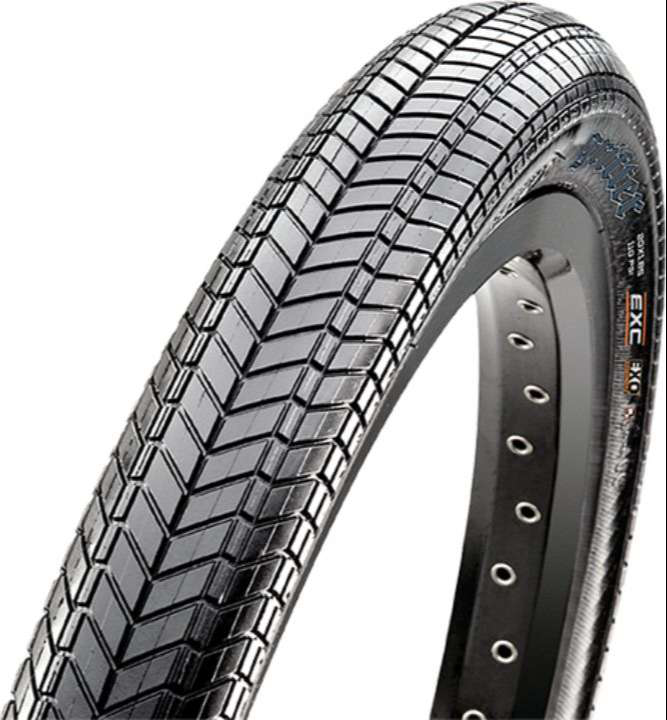
Another BMX tire trying to perform well enough to be used on a dirt jump track. It’s hard to find BMX tires that suit DJ tracks but I think Maxxis have provided an awesome all-round tire here. One of the reasons I have included this tire here is the number of positive reviews it’s received. Many people claim it to be the best all-round tire for BMX bikes.
“They last for years.”
“Brilliant grip that lasts for ages.”
“Perfect for park or dirt”
These are just some of the quotes that have been repeated over and over again.
Maxxis used it’s near 50 years of experience to implement some of their best technologies. Dual compound technology, foldable bead, silkworm bead-to-bead protection and a fast, directional tread pattern have amalgamated into one of the best freestyle tires available.
I’m not the biggest fan of this tread pattern but the aesthetics aren’t the most important part. Each tread shape is super smooth and placed relatively close together. Once worn in this pattern will allow a lot of speed generation and dialled landings.
Specifications:
- Bead: Wire, Foldable
- TPI: 60, 120
- Weight: 453g, 605g
- Max PSI: 110PSI
- Technology: EXO, SilkShield
Click Here to Check Best Price
5. Kenda K-Rad Slopestyle Bike Tire
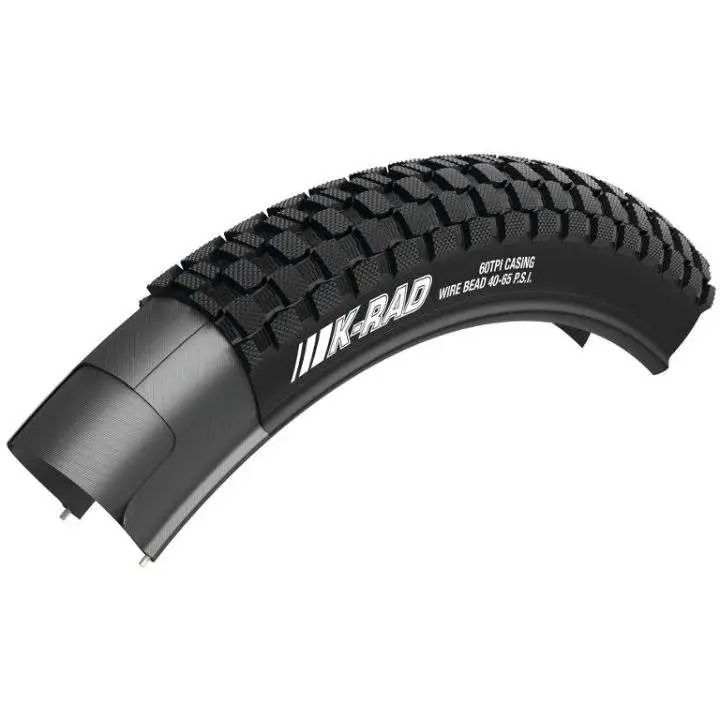
Unsurprisingly we have another Kenda tire on this list. This tire has an old school tread pattern that’s been used on dirt jump and mountain bikes for years. If you ever bought a beginner or intermediate DJ bike it’s likely you received a tire with a checkerboard tread pattern like these.
The reason this pattern was so popular is due to the wide-ranging riding disciplines it could be used for. Bike manufacturers didn’t need to worry about customers not enjoying the tires supplied with their bikes as the tires were suitable for nearly every type of rider.
The Kenda K-Rad tires aren’t just a checkerboard pattern. The design features a knurled tread surface and control ribbing between the knobs. Steel casing/wire bead was used for a super-strong product.
Many riders have had great results when using these tires for their daily commute and weekend mountain bike riding. Each knob has a fairly large surface area and when pumped up sufficiently they are brilliant at providing a consistent grip when riding fast on concrete.
I believe a good amount of speed and cornering has been achieved from the symmetrical pattern being spread over a large amount of the tire. You can lean quite hard into a corner before coming to the edge of the tire’s tread.
Wet mud and excessive water are the only commonly noted disadvantages to this tire. Again, this won’t cause much of a problem to dirt jump riders but might not be perfect for the average mountain biker.
Specifications:
- Width: 2.5”
- Tire Size: 24”
- Tread Design: Checkerboard
- Weight: 895g
Click Here to Check Best Price
6. Fly Bikes Ruben BMX Tires
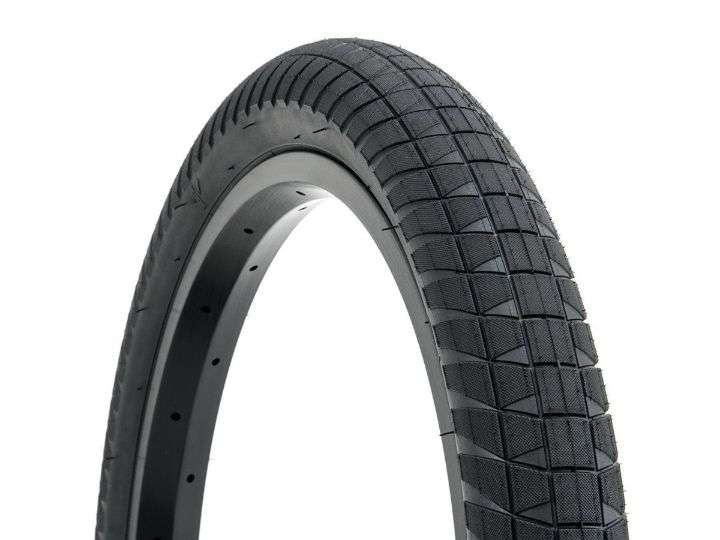
My first proper BMX was a Fly Bikes Neutron. It’s an amazing bike and it’s the bike that really made me fall in love with BMX. Many of the parts are signature Ruben pieces and I cannot recommend them enough. They’re brilliantly designed and super high quality.
Ruben Alcantara is the face behind loads of Fly Bikes’ most popular bike parts. Ruben can easily be described as the mountain bikers BMXer. The Spanish rider has an incredibly unique style, out the box thinking and all the confidence necessary to go as big as possible.
In recent years Alcantara and his associates have been working on a project we’ve all thought about at some point. A BMX bike with all the suspension and brakes necessary to ride on proper mountain bike trails. I believe his aim is for the jump tracks at Whistler.
Taking a look at the images he’s released of the first full-suspension BMX they’ve made is very exciting. 100mm of front fork travel, 90mm in the rear, two hydraulic disc brakes, massive 2.8” tires and of course those beautiful 20” wheels.
Back to the dirt jump tires. This is the tire that came with my Neutron and I’ve never changed it. The pattern is quite generic with squares lining the centre line, amputated triangles hugging the squares and larger angled shapes on the sidewalls. The tires come in two sizes, both of which are pretty big.
The size of the tires along with the micro knurling is great for dirt and very forgiving. The only weakness comes in autumn and winter. If you have regular forks with a relatively small gap between the top of the tire and bottom of the forks then these tires are going to be a pain in the colder months. Dirt and especially leaves are deposited with vigour inside the forks. Once full, this unwanted amalgamation of dirt and leaves will act as a handbrake on your front wheel.
If you have a good amount of fork clearance then I have nothing to complain about. I would definitely buy them again. Underneath the tread Fly has added a pinch-resistant layer, giving even more confidence to the dirt jumpers sending big jumps.
Specifications:
- Material: 60 TPI
- Max Pressure: 110 PSI
- Sizes: 2.15”, 2.35”
- Weight: 550g – 750g
- Puncture Resistant Layer
- Pinch Resistant Layer
Click Here to Check Best Price
7. Tioga Comp III Race Tire
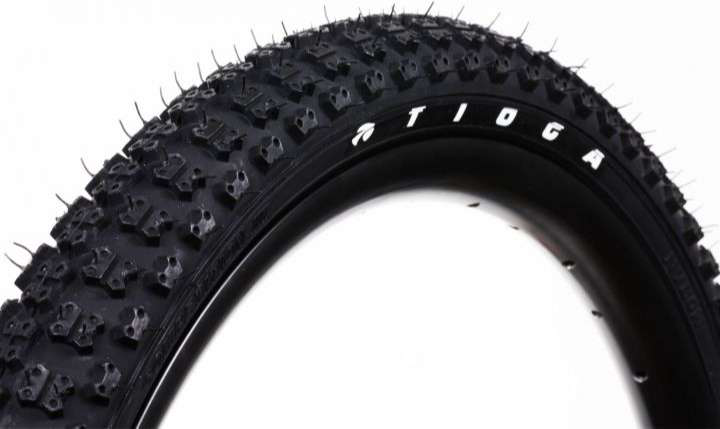
Another tire you’ve almost definitely seen before, this time probably in the BMX world. Developed back in ‘83, these tires have become popular in many different disciplines. Originally, the Comp III was designed for the racetrack but it wasn’t long before riders started using them for trail and ramp riding. This is why I’d easily recommend them for dirt jumping.
Available in 5 different sizes from 20 x 1-⅛“ up to 20 x 2.125”, these tires have great sidewall strength. A rubber and nylon design with a thin rubber coating over the nylon cords has helped with this strength.
The Comp III tire is getting old now. The fact it’s still so popular with only minor design changes is a good testament to the quality of the product. An interesting analysis of the treat pattern was made by Kai Cheng, of Tioga. He said they wanted a tire with knobs positioned at many different edges and angles so the tire is much better at digging into and getting a bite on loose dirt. As you know, a lot of jump tracks and race tracks feature loose dirt and gravel. This tread pattern will definitely help.
Specifications:
- Sizes: 20”
- Tire Width: 1.75”
- Bead: Steel
- TPI: 66
- Weight: 460g
Click Here to Check Best Price
8. DMR Moto RT Slopestyle Tire
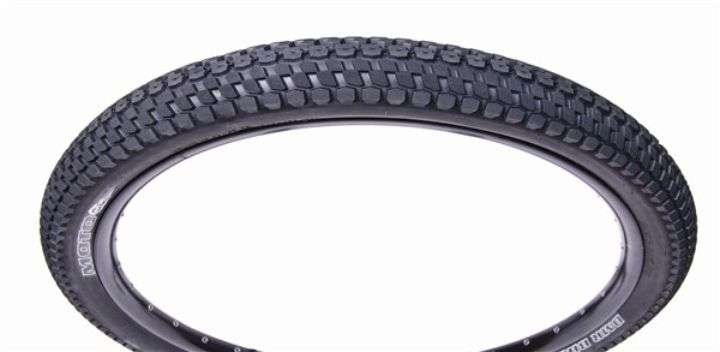
Another great tire from DMR. I think this is one of my top 3 on this list. A fairly simple design for 24 and 26” wheels. The Moto RT is aimed at park riders and DJ trail riders. The RT itself stands for road and trail. Again, this tire is best suited to hard-packed dirt with semi-favourable conditions.
A sleek, directional tread pattern with lightweight rubber gives the rider easy speed and really responsive ride. DMR have used a large volume casing, reducing the likelihood of punctures when you don’t land a jump the way you intended. We’ve all done it so you know it’s a good feature.
The centre-line is made up of squares with slight angles on either side. There are then three rows of checkerboard shapes around either side. These rows vary in size and shape but are the same on both sides. Every knob has micro knurling for that slight advantage it offers. It’s a simple pattern design but the design is surprisingly unique and I like it.
Specifications:
- Size: 26”
- Bead: Wire, Folding
- Weight: 810g – 900g
- Tread Pattern: Directional
- TPI: 60
Click Here to Check Best Price
Where are Maxxis Tires Made?
Maxxis tires are made in a variety of locations around the world, including China, Taiwan, Thailand, the United States, and Vietnam.
The specific location where a particular Maxxis tire is made will depend on the type of tire and the market it is intended for. For example, some Maxxis tires are made in the United States for the North American market, while others are made in Asia for the global market.
Additionally, Maxxis operates multiple manufacturing facilities in each of these countries, so the exact location where a tire is made may vary.
How to Check my Dirt Jump Tires are Compatible with my Bike?
To check whether your dirt jump tires are compatible with your bike, you will need to consider several factors, including the size of the tire, the width of the rim, the type of tire and wheel setup your bike is designed for. Here are some steps you can follow to determine whether your dirt jump tires are compatible with your bike:
- Measure the size of your dirt jump tires: Dirt jump tires are typically measured by their diameter and width. Your tires will show the dimensions on the side of them. If you don’t know the size of your time you can measure the diameter and width with a tape measure.
- Measure the width of your bike’s rims: The width of your bike’s rims will determine the maximum width of tire that can be used on your bike. To measure the width of your rims, use a tape measure or ruler to measure the distance between the inside of the rim on one side to the inside of the rim on the other side. Be sure to measure the width of the rim where the tire will be mounted, not at the center of the wheel.
- Check the tire and wheel setup of your bike: Different bikes are designed to use different tire and wheel setups. For example, some bikes use a traditional wheel and tire setup with a separate tire and inner tube, while others use a tubeless setup where the tire and wheel form a sealed unit without an inner tube. Make sure the tire and wheel setup of your bike is compatible with the type of dirt jump tires you are using.
- Check the tire clearance of your bike: The tire clearance of your bike refers to the amount of space between the frame and the tire when the wheel is fully turned. This is important because it determines the maximum size of tire that can be used on your bike. To check the tire clearance of your bike, measure the distance between the frame and the tire when the wheel is fully turned. If the distance is less than the width of your dirt jump tires, they may not be compatible with your bike.Should I use a Tubeless MTB Tire?Whether or not you should use a tubeless MTB tire will depend on your personal preferences and the specific conditions in which you will be riding. Here are some potential benefits and drawbacks to using a tubeless MTB tire:Benefits:
- Tubeless bike tires can provide a smoother, more comfortable ride because they are able to absorb small impacts and vibrations more effectively than traditional tires with inner tubes.
- They can also provide better traction and control, particularly in wet or muddy conditions, because they are able to conform to the terrain more easily.
- Tubeless wheels can be run at lower pressures, which can improve traction and comfort, but also reduce the risk of pinch flats (also known as snake bites) where the tire is punctured by the rim.
- Tubeless tires are also generally lighter than traditional tires with inner tubes, which can improve the overall performance and handling of your bike.
- Tubeless tires can be more difficult to install and maintain than traditional tires with inner tubes. They require the use of special sealant, which can be messy and can sometimes leak from the tire.
- These tires can also be more expensive than traditional tires with inner tubes, particularly if you need to purchase a special tubeless-ready wheel set or conversion kit.
- In some cases, tubeless tires may not be compatible with certain types of rims or wheels, so you may need to purchase new wheels in order to use them.
- Some riders may also experience problems with burping, where the tire loses air due to a loss of seal between the tire and the rim, particularly when riding over rough terrain.
- Maxxis Minion DHF: The Minion DHF is a popular all-mountain and enduro tire that is known for its burly construction and aggressive tread pattern. It features a dual-ply casing and a triple-compound rubber compound that provides excellent puncture resistance and durability.
- Schwalbe Nobby Nic: The Nobby Nic is a versatile cross-country and all-mountain tire that is known for its high-volume casing and robust SnakeSkin sidewalls. It is available in a variety of sizes and tread patterns, and is designed to provide excellent puncture resistance and traction on a wide range of terrain.
- Continental Trail King: The Trail King is a popular enduro and all-mountain tire that is known for its durable construction and aggressive tread pattern. It features a reinforced casing and a protective Apex layer that provides excellent puncture resistance and helps to prevent cuts and punctures.
- Specialized Ground Control: The Ground Control is a versatile cross-country and trail tire that is known for its fast-rolling tread pattern and puncture-resistant casing. It features a durable 120 TPI (threads per inch) casing and a reinforced bead that provides excellent puncture resistance and helps to prevent flats.


